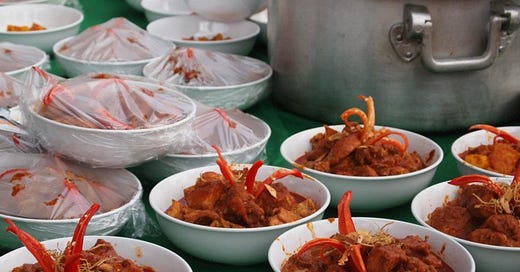The provenance of ‘Devil Curry’ begins with Vinho d'alho a Portuguese dish of pork marinated with garlic and wine vinegar. Vinho d'alho became Vindaloo in Goa then continued to Malacca where it remained on Eurasian menus but evolved further to include ingredients from local Malay Rempahs like Turmeric, Galangal, Candlenuts, Lemongrass and even browning of the meat with a little Soy Sauce, transforming into a more localised identity we now know as Devil Curry.
There is a clear variation in recipes from various Eurasian sources, Robin Pereira of Quentin's restaurant and Mary Gomez’s The Eurasian Cookbook version only has as its key ingredients chillies, mustard seeds and vinegar, leaving out Vindaloo’s Indian curry spices like cinammon, clove, and anise whilst Celia Marbeck's recipe from Cristang Cuizinhas and Melba Nunis’ Kristang Family Cookbook are the same but with the addition of a local Malay rempah spice mix that includes lemongrass, candelnuts and galangal. There seems to be a Singapore, Burgher/Anglo Indian version and a Malacca Kristang/Portuguese Eurasian version in play. Singapore Eurasian Ellice Handy’s landmark cookbook My Favourite Recipes first published in 1952 has a Devil Curry’recipe that is much like the former. This nuance is similar to the difference between how Burgher Eurasians make Love cake versus Malacca Eurasians who make Sugee Cake.
Despite the differences in style, the results tend to be somewhat similar - a vibrantly red spicy curry of meat and potatoes with its signature tangy vinegar flavour. The key ingredients of Chillies and Potatoes, whilst being introduced by the Portuguese took a while to become popular in the East. Chillies were slow to replace black peper as a source of heat in India, only catching fire so to speak in the 18th century when it spread northwards and then throughout Asia. Whilst starchy vegetables like the potato, sweet potato, and cassava were cultivated in India by the 16th century, they only gained momentum in the 19th century when the British campaigned to grow more of these food plants providing incentives like seeds and transit tax exemptions to farmers to do so. See: How potatoes and chillies conquered Indian cuisine
Devil curry is in fact a newer name for this dish. Its original name was ‘Debal’ curry, which has been a source of controversy and debate within the Eurasian community. Its been described as a dish utilising leftovers of roast meats from the Christmas meal, ‘debal’ meaning leftovers in Kristang and therefore cooked only during Christmas or other festivites. Many Eurasians refute this saying its cooked throughout the year and never with leftovers.
I reached out to Kevin Martens Wong a PhD in linguistics and founder of Kodrah Kristang in Singapore, whose mission is to revitalize the critically endangered Kristang language in Singapore, and he confirmed that debal does in fact mean ‘leftovers’ - its listed on their online dictionary of Kristang words Libru Lontrah as debal. n. leftovers, extra, additional.
Most Eurasian cookbook authors also describe it as a Christmas specialty, here are some quotes:
“This is the curry most associated with Eurasians. it is cooked for special occasions like Christmas or any other big festivities” Mary Gomes, The Eurasian Cookbook
“On Boxing Day, the family feast assumes a more modest scale featuring debal, a dish concoted from leftovers as the main item on the menu.” Celine Marbeck, Cuzinhia Cristang
In Melba Nunis’ Kristang Family Cookbook, Devil Curry is listed under ‘Christmas Dishes’
There is also a Portuguese tradition for cooking leftovers at Christmas. On Christmas Day, many Portuguese families eat Roupa Velha, meaning Old Rags. Leftovers of Christmas Eve Cod prepared for lunch on December 24 is mixed with potatoes, cabbage, and eggs for this dish then served before the meat course on Christmas day.
The use of the culinary term ‘devilled’ to mean ‘highly seasoned first appeared in the 18th century and by the 19th century meant to cook something ‘with fiery hot spices or condiments.’ This coincided with the British Malaya colonial era perhaps explaining the name Debal migrating to Devil Curry.
Less hotly contested but representing a variety of individual family preparation styles is the addition of vegetables like cabbage, Chinese roast meats (Siew Yoke) and cocktail sausages. There’s also a difference in whether the gravy is thick and dry or watery. My personal preference is less dry, pork or chicken with potatoes with nothing else, and made from the the Malacca rempah based recipe. I also like to use locally grown sweet potatoes instead of imported potatoes because of their eco friendlier footprint and the sweeter flavour adds an interesting flavour contrast to the tangy vinegar. Devil curry is on the menu, if you ask at a couple of restaurants in the Portuguese settlement in Malacca; at Big Ben’s also in Malacca; and Kumi in KL who also make a Devil Curry pie that is worth trying.
More Devil Curry Stories:
Malacca’s forbidding Debal Curry: BBC
The Dish: Curry Debal Wall Street Journal
My Debal Diaries Melissa Da Silva, CNA
Why you shouldn’t get into arguments about Devil’s Curry with Eurasians Andre Frois, Rice Media
The photo of Devil curry at the top was taken at the 500 year anniversary celebrations of the Portuguese arriving in Malacca





